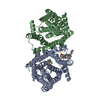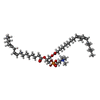[English] 日本語
 Yorodumi
Yorodumi- PDB-9g0x: auxin transporter PIN8 as asymmetric dimer (inward/outward) with ... -
+ Open data
Open data
- Basic information
Basic information
| Entry | Database: PDB / ID: 9g0x | ||||||
|---|---|---|---|---|---|---|---|
| Title | auxin transporter PIN8 as asymmetric dimer (inward/outward) with 4-CPA bound in the inward vestibule prebinding state | ||||||
 Components Components | Auxin efflux carrier component 8 | ||||||
 Keywords Keywords | MEMBRANE PROTEIN / Auxin transport / AEC family / BART superfamily / TRANSPORT PROTEIN | ||||||
| Function / homology |  Function and homology information Function and homology informationauxin export across the plasma membrane / auxin efflux transmembrane transporter activity / pollen development / auxin-activated signaling pathway / cell periphery / endoplasmic reticulum membrane / endoplasmic reticulum / protein homodimerization activity / identical protein binding / plasma membrane Similarity search - Function | ||||||
| Biological species |  | ||||||
| Method | ELECTRON MICROSCOPY / single particle reconstruction / cryo EM / Resolution: 3.38 Å | ||||||
 Authors Authors | Ung, K.L. / Stokes, D.L. / Pedersen, B.P. | ||||||
| Funding support | European Union, 1items
| ||||||
 Citation Citation |  Journal: bioRxiv / Year: 2024 Journal: bioRxiv / Year: 2024Title: Transport of herbicides by PIN-FORMED auxin transporters. Authors: Lukas Schulz / Kien Lam Ung / Sarah Koutnik-Abele / David L Stokes / Bjørn Panyella Pedersen / Ulrich Z Hammes /    Abstract: Auxins are a group of phytohormones that control plant growth and development . Their crucial role in plant physiology has inspired development of potent synthetic auxins that can be used as ...Auxins are a group of phytohormones that control plant growth and development . Their crucial role in plant physiology has inspired development of potent synthetic auxins that can be used as herbicides . Phenoxyacetic acid derivatives are a widely used group of auxin herbicides in agriculture and research. Despite their prevalence, the identity of the transporters required for distribution of these herbicides in plants is both poorly understood and the subject of controversial debate . Here we show that PIN-FORMED auxin transporters transport a range of phenoxyacetic acid herbicides across the membrane and we characterize the molecular determinants of this process using a variety of different substrates as well as protein mutagenesis to control substrate specificity. Finally, we present Cryo-EM structures of PIN8 with 2,4-dichlorophenoxyacetic acid (2,4-D) or 4-chlorophenoxyacetic acid (4-CPA) bound. These structures represent five key states from the transport cycle, allowing us to describe conformational changes associated with substrate binding and transport across the membrane. Overall, our results reveal that phenoxyacetic acid herbicides use the same export machinery as endogenous auxins and exemplify how transporter binding sites undergo transformations that dictate substrate specificity. These results enable development of novel synthetic auxins and for guiding precision breeding of herbicide resistant crop plants. #1:  Journal: Nat.Plants / Year: 2025 Journal: Nat.Plants / Year: 2025Title: Transport of phenoxyacetic acid herbicides by PIN-FORMED auxin transporters Authors: Schulz, L. / Ung, K.L. / Zuzic, L. / Koutnik-Abele, S. / Stokes, D.L. / Pedersen, B.P. / Hammes, U.Z. | ||||||
| History |
|
- Structure visualization
Structure visualization
| Structure viewer | Molecule:  Molmil Molmil Jmol/JSmol Jmol/JSmol |
|---|
- Downloads & links
Downloads & links
- Download
Download
| PDBx/mmCIF format |  9g0x.cif.gz 9g0x.cif.gz | 229.3 KB | Display |  PDBx/mmCIF format PDBx/mmCIF format |
|---|---|---|---|---|
| PDB format |  pdb9g0x.ent.gz pdb9g0x.ent.gz | Display |  PDB format PDB format | |
| PDBx/mmJSON format |  9g0x.json.gz 9g0x.json.gz | Tree view |  PDBx/mmJSON format PDBx/mmJSON format | |
| Others |  Other downloads Other downloads |
-Validation report
| Summary document |  9g0x_validation.pdf.gz 9g0x_validation.pdf.gz | 1.5 MB | Display |  wwPDB validaton report wwPDB validaton report |
|---|---|---|---|---|
| Full document |  9g0x_full_validation.pdf.gz 9g0x_full_validation.pdf.gz | 1.5 MB | Display | |
| Data in XML |  9g0x_validation.xml.gz 9g0x_validation.xml.gz | 40.9 KB | Display | |
| Data in CIF |  9g0x_validation.cif.gz 9g0x_validation.cif.gz | 57.4 KB | Display | |
| Arichive directory |  https://data.pdbj.org/pub/pdb/validation_reports/g0/9g0x https://data.pdbj.org/pub/pdb/validation_reports/g0/9g0x ftp://data.pdbj.org/pub/pdb/validation_reports/g0/9g0x ftp://data.pdbj.org/pub/pdb/validation_reports/g0/9g0x | HTTPS FTP |
-Related structure data
| Related structure data |  50951MC  9g0wC  9g0zC  9g10C M: map data used to model this data C: citing same article ( |
|---|---|
| Similar structure data | Similarity search - Function & homology  F&H Search F&H Search |
- Links
Links
- Assembly
Assembly
| Deposited unit | 
|
|---|---|
| 1 |
|
- Components
Components
| #1: Protein | Mass: 41541.039 Da / Num. of mol.: 2 Source method: isolated from a genetically manipulated source Source: (gene. exp.)   #2: Chemical | ChemComp-A1IHP / | Mass: 186.592 Da / Num. of mol.: 1 / Source method: obtained synthetically / Formula: C8H7ClO3 / Feature type: SUBJECT OF INVESTIGATION #3: Chemical | #4: Water | ChemComp-HOH / | Has ligand of interest | Y | Has protein modification | N | |
|---|
-Experimental details
-Experiment
| Experiment | Method: ELECTRON MICROSCOPY |
|---|---|
| EM experiment | Aggregation state: PARTICLE / 3D reconstruction method: single particle reconstruction |
- Sample preparation
Sample preparation
| Component | Name: auxin transporter PIN8 as asymmetric dimer (inward/outward) with 4-CPA bound in the inward vestibule prebinding state Type: COMPLEX / Entity ID: #1 / Source: RECOMBINANT | ||||||||||||||||||||||||||||||
|---|---|---|---|---|---|---|---|---|---|---|---|---|---|---|---|---|---|---|---|---|---|---|---|---|---|---|---|---|---|---|---|
| Molecular weight | Value: 0.081 MDa / Experimental value: NO | ||||||||||||||||||||||||||||||
| Source (natural) | Organism:  | ||||||||||||||||||||||||||||||
| Source (recombinant) | Organism:  | ||||||||||||||||||||||||||||||
| Buffer solution | pH: 7.5 | ||||||||||||||||||||||||||||||
| Buffer component |
| ||||||||||||||||||||||||||||||
| Specimen | Embedding applied: NO / Shadowing applied: NO / Staining applied: NO / Vitrification applied: YES | ||||||||||||||||||||||||||||||
| Specimen support | Details: The grid was glow-discharge at 15 mA / Grid material: COPPER / Grid mesh size: 300 divisions/in. / Grid type: C-flat-1.2/1.3 | ||||||||||||||||||||||||||||||
| Vitrification | Instrument: FEI VITROBOT MARK IV / Cryogen name: ETHANE / Humidity: 100 % / Chamber temperature: 277.15 K Details: Wait 4 seconds after sample loading, Blotting time 4 seconds with blotting force of -1 before plunging |
- Electron microscopy imaging
Electron microscopy imaging
| Experimental equipment |  Model: Titan Krios / Image courtesy: FEI Company |
|---|---|
| Microscopy | Model: FEI TITAN KRIOS |
| Electron gun | Electron source:  FIELD EMISSION GUN / Accelerating voltage: 300 kV / Illumination mode: FLOOD BEAM FIELD EMISSION GUN / Accelerating voltage: 300 kV / Illumination mode: FLOOD BEAM |
| Electron lens | Mode: BRIGHT FIELD / Nominal magnification: 130000 X / Nominal defocus max: 2000 nm / Nominal defocus min: 600 nm / Cs: 2.7 mm / Alignment procedure: COMA FREE |
| Specimen holder | Cryogen: NITROGEN / Specimen holder model: FEI TITAN KRIOS AUTOGRID HOLDER |
| Image recording | Electron dose: 58.4 e/Å2 / Film or detector model: GATAN K3 BIOQUANTUM (6k x 4k) / Num. of grids imaged: 1 / Num. of real images: 14665 |
| EM imaging optics | Energyfilter name: GIF Bioquantum / Energyfilter slit width: 20 eV |
| Image scans | Sampling size: 5 µm / Width: 5760 / Height: 4092 |
- Processing
Processing
| EM software |
| ||||||||||||||||||||||||||||||||
|---|---|---|---|---|---|---|---|---|---|---|---|---|---|---|---|---|---|---|---|---|---|---|---|---|---|---|---|---|---|---|---|---|---|
| CTF correction | Details: CTF amplitude correction was performed following motion correction using cryosparc-live Type: PHASE FLIPPING AND AMPLITUDE CORRECTION | ||||||||||||||||||||||||||||||||
| Particle selection | Num. of particles selected: 8093919 | ||||||||||||||||||||||||||||||||
| Symmetry | Point symmetry: C1 (asymmetric) | ||||||||||||||||||||||||||||||||
| 3D reconstruction | Resolution: 3.38 Å / Resolution method: FSC 0.143 CUT-OFF / Num. of particles: 115380 / Algorithm: FOURIER SPACE / Num. of class averages: 1 / Symmetry type: POINT | ||||||||||||||||||||||||||||||||
| Atomic model building | B value: 94.4 / Space: REAL | ||||||||||||||||||||||||||||||||
| Atomic model building | PDB-ID: 7QP9 Accession code: 7QP9 / Source name: PDB / Type: experimental model | ||||||||||||||||||||||||||||||||
| Refine LS restraints |
|
 Movie
Movie Controller
Controller





 PDBj
PDBj



